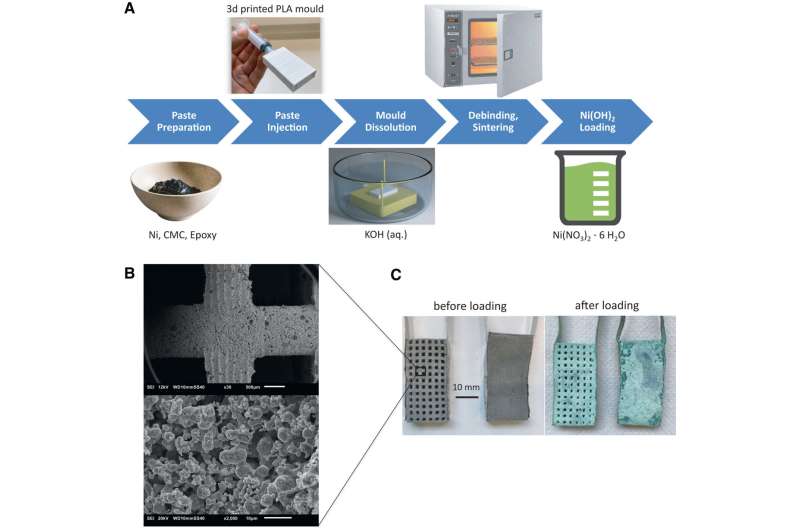Enhanced 3D electrode design stores electricity four times faster than before
A new 3D design for electrodes enables the Battolyser, a battery and electrolyzer in one, to store twice the amount of electricity it could previously hold and do so four times faster. Researchers from Delft University of Technology have detailed their findings in the journal Cell Reports Physical Science. The Battolyser now charges and produces hydrogen at a rate comparable to current electrolyzers, all without relying on scarce precious metals. This increased capacity saves both space and costs.
To facilitate the energy transition, we need two types of storage for renewable energy: batteries for day and night storage and hydrogen for seasonal storage. The Battolyser, a hybrid battery and electrolyzer, serves both functions with a single device.
Additionally, electrolysis powered by renewable energy produces green hydrogen, unlike conventional hydrogen production methods that rely on fossil fuels. Professor Fokko Mulder conceived the Battolyser concept in 2013, which later evolved into a spin-off in 2018 and entered the market in 2021 as Battolyser Systems.
Thanks to the innovative 3D electrode design, the Battolyser can now store twice the amount of electricity and does so up to four times faster than before. This enables the Battolyser to charge and produce hydrogen at a rate comparable to existing electrolyzers, without relying on rare precious metals. It can also switch between charging and electrolysis to discharging, a feature that standard electrolyzers lack.
Reduced space and costs
The new electrodes enhance the flow of electricity through the Battolyser and improve the efficiency of gas removal during electrolysis, explains Mulder. “This saves space and costs, as these more powerful electrodes mean we need to produce fewer cells. Consequently, fewer cells are required to store the same amount of charge while they can produce more hydrogen.”
“To illustrate the potential space savings: with this upgrade, we could replace a planned Eneco electrolyzer covering 20 football pitches and a GIGA Storage lithium battery spanning 15 football pitches with a Battolyser that is only as large as the electrolyzer itself,” Mulder adds.
“With fewer cells, we also require fewer expensive components, such as membranes that separate hydrogen and oxygen, and current collectors that direct electricity to the electrodes,” the physicist continues.
“Using four times fewer materials for the cells translates to a 75% reduction in material costs. This should lead to lower material usage and costs as we scale up.”
The green energy market
Lead author Robin Möller-Gulland investigated how to enhance the charging speed and capacity of the Battolyser for his doctoral research. Together with Mulder, he developed the new electrode structure featuring channels for electrolyte to improve conductivity. The goal was for the battery to charge for at least an hour and discharge in four hours, matching the charging speed of an electrolyzer without precious metals.
Mulder says, “This aligns well with the needs of the green energy market in the future, as peaks in energy surplus and shortages typically occur over approximately four hours. During this time, both (dis)charging and hydrogen production must be realized.”
Möller-Gulland adds that the charging speed has also improved, saying, “Achieving 82% charge in just 18 minutes is now possible without sacrificing battery capacity.”
More information:
Robin Möller-Gulland et al, 3D nickel electrodes for hybrid battery and electrolysis devices, Cell Reports Physical Science (2024). DOI: 10.1016/j.xcrp.2024.102286
Delft University of Technology
Citation:
Enhanced 3D electrode design stores electricity four times faster than before (2024, December 2)
retrieved 3 December 2024
from https://techxplore.com/news/2024-12-3d-electrode-electricity-faster.html
This document is subject to copyright. Apart from any fair dealing for the purpose of private study or research, no
part may be reproduced without the written permission. The content is provided for information purposes only.

Comments are closed